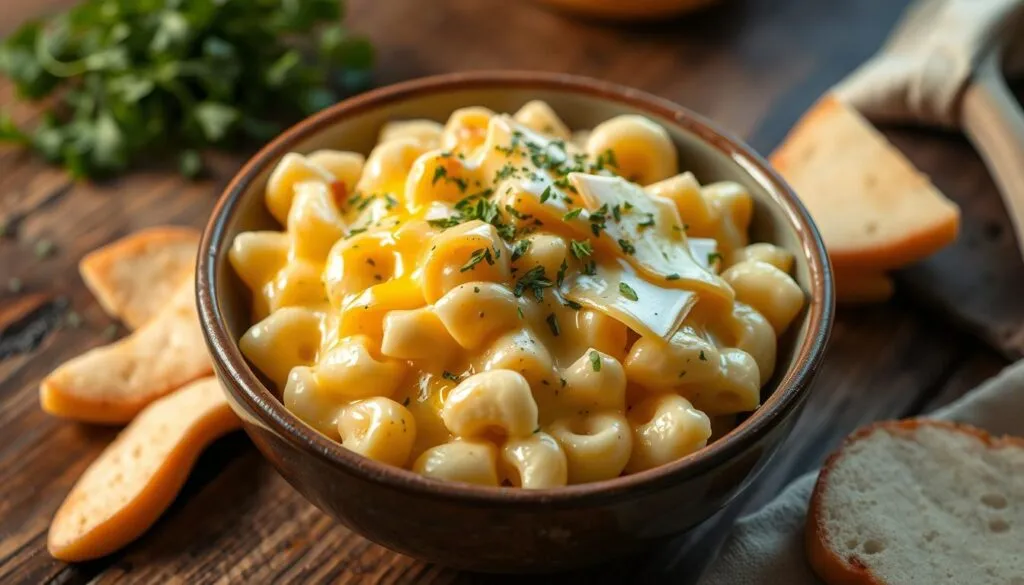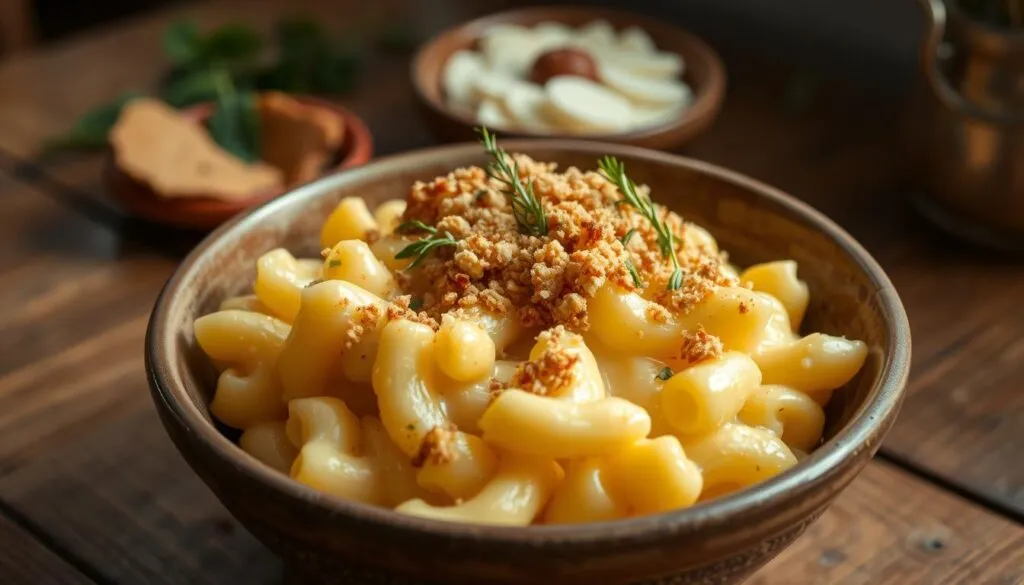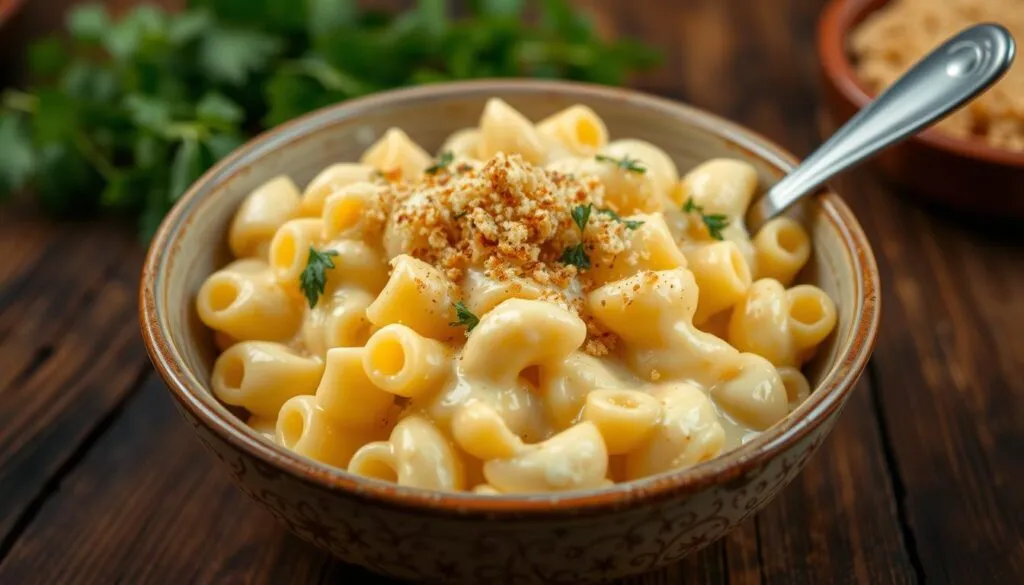Asking Is Gouda good for mac and cheese? The answer is yes. Gouda mac and cheese is a favorite for many. It brings a creamy and smoky taste that makes the dish irresistible. We’ll look into why gouda is great for mac and cheese, like its melting ability and how to mix it with other cheeses.
Adding gouda to your mac and cheese can make it even better. It gives a creamy and tangy flavor. Whether you love traditional mac and cheese or want to try something new, gouda is a great choice. So, is gouda good for mac and cheese? Let’s explore.
Gouda’s high fat content makes it perfect for a creamy sauce. Mixing it with cheddar or parmesan makes the dish unforgettable. So, if you want to elevate your mac and cheese, try gouda. You’ll love it.
Understanding Gouda: A Brief Cheese Profile
Gouda cheese is versatile, with many flavors and textures. It’s perfect for mac and cheese. Gouda adds a rich, creamy taste to dishes, making it a top choice.
Gouda is made from fresh milk, which can be raw or pasteurized. The cheese-making process involves adding bacteria and rennet enzyme. This creates Gouda’s unique flavor and texture, ideal for mac and cheese.
Types of Gouda Available
There are many types of Gouda, each with its own taste. Smoked Gouda has a smoky flavor, while young Gouda is mild and creamy. Aged Gouda has a nutty, caramel taste, great for snacking or recipes.
Flavor Profile Variations
The taste of Gouda changes with age and production. Young Gouda is mild and creamy, while aged Gouda is richer. Smoked Gouda adds a smoky depth to dishes. Choose the type that suits your taste.

Aging Process and Its Effects
The aging process affects Gouda’s flavor and texture. As it ages, Gouda becomes more complex and dense. The aging time varies, from months to years. Consider the aging when picking Gouda for your recipes.
Gouda is a fantastic choice for mac and cheese. Its rich, creamy taste and dense texture make it versatile. It’s great in mac and cheese, salads, and snacks.
The Melting Properties of Gouda Cheese
Gouda cheese is key to a creamy mac and cheese. Its melting properties make it perfect for this dish. The cheese’s moisture and fat content help it melt evenly.
Choosing the right gouda is important. Smoked gouda adds a rich flavor, while extra-sharp cheddar brings a tangy taste. Together, they create a balanced flavor.
Here are some tips for using gouda in mac and cheese:
- Shred the cheese from block form to avoid anti-caking agents.
- Use a mix of cheeses for a balanced flavor.
- Stay away from low-fat cheeses to avoid a grainy texture.

Gouda’s high moisture content prevents a chalky texture. Its creamy flavor makes it a top choice for mac and cheese.
| Cheese Type | Moisture Content | Melting Properties |
|---|---|---|
| Gouda | High | Excellent |
| Cheddar | Medium | Good |
| Mozzarella | High | Excellent |
Is Gouda Good for Mac and Cheese? An Expert Analysis
Using Gouda in mac and cheese has many benefits. It adds a creamy texture and a rich flavor. Its melting properties also make it a great choice for this dish.
Gouda’s creamy texture and rich flavor can make mac and cheese better. It’s a favorite among chefs and home cooks. This cheese can enhance the dish’s taste and feel.
Gouda is high in calories and fat but also in protein and calcium. One ounce has about 200 calories, 16 grams of fat, and 14 grams of protein. It’s a good addition to a balanced diet.
Texture Considerations
Gouda’s creamy texture is perfect for mac and cheese. It melts smoothly, creating a velvety sauce. This texture, along with its flavor, makes Gouda a great choice.
Flavor Impact on the Dish
Gouda’s rich, nutty flavor adds depth to mac and cheese. Its unique taste, developed through aging, makes the dish more enjoyable. It adds complexity and satisfaction.
Melting Behavior in Pasta
Gouda melts well at a low temperature, ensuring a smooth sauce. Its melting properties, along with its flavor and texture, make it ideal for mac and cheese.

In conclusion, Gouda is a great choice for mac and cheese. Its unique texture, rich flavor, and melting properties make it excellent. Whether you’re a chef or a home cook, adding Gouda will enhance your dish, making it a delightful experience.
Best Ways to Use Gouda in Mac and Cheese
To make the best gouda mac and cheese, mix gouda with other ingredients. This dish is loved for its creamy flavor. Gouda is a top choice because it melts well and adds richness.
Here are some tips for using gouda in mac and cheese:
- Use a combination of gouda and other cheeses, such as cheddar or parmesan, for a unique flavor profile.
- Experiment with different types of gouda, such as smoked or aged gouda, to add depth to the dish.
- Don’t overcook the pasta, as this can make the dish dry and unappetizing.
A typical recipe for gouda mac and cheese includes the following ingredients:
| Ingredient | Quantity |
|---|---|
| Dry elbow macaroni | 12 ounces |
| Unsalted butter | ¼ cup |
| All-purpose flour | ¼ cup |
| Whole milk | 2 and ½ cups |
| Table salt | ¼ teaspoon |
| Black pepper | ¼ teaspoon |
| Shredded sharp cheddar cheese | 8 ounces |
| Shredded gouda | 4 ounces |

Nutritional information per serving:
| Nutrient | Quantity |
|---|---|
| Calories | 579 kcal |
| Carbohydrates | 52 g |
| Protein | 25 g |
| Fat | 30 g |
Comparing Gouda to Traditional Mac and Cheese Cheeses
Choosing the right cheese for mac and cheese can change the dish’s flavor and texture. Gouda cheese is a favorite, but how does it stack up against cheddar, American cheese, and Gruyère? Let’s look at each cheese’s unique qualities and how they affect the dish.
Gouda cheese’s taste and texture change with age. Young Gouda is mild and sweet, while aged Gouda is strong and savory. Cheddar, a top pick in the U.S., comes in sharp and mild varieties. Gruyère, rich in fat, makes dishes like fondue and mac and cheese creamy.
Characteristics of Traditional Mac and Cheese Cheeses
- Cheddar: sharp or mild, high moisture content, ideal for achieving stringy pulls
- American Cheese: mild, creamy, and smooth, often used in combination with other cheeses
- Gruyère: nutty, earthy, and sweet, becomes creamy when heated without greasiness
When mixing Gouda with other cheeses, a 1-to-2 ratio with creamier cheeses works best. The moisture content of each cheese affects the dish’s texture. For example, mild cheddar’s high moisture content is great for stringy pulls. Freshly grated cheese melts better than pre-shredded, thanks to fewer anti-caking agents.
The right cheese for mac and cheese depends on your taste and the flavor you want. Knowing each cheese’s unique qualities lets you make a dish that highlights Gouda or tries other cheeses for a new taste.
| Cheese Type | Flavor Profile | Texture |
|---|---|---|
| Gouda | Mild and sweet (young), strong and savory (aged) | Creamy (young), firm (aged) |
| Cheddar | Sharp or mild | Stringy, high moisture content |
| Gruyère | Nutty, earthy, and sweet | Creamy, high fat content |
Tips for Cooking with Gouda in Mac and Cheese
When cooking with gouda, like in mac and cheese, it’s key to know the type and how it melts. Smoked gouda, for instance, brings a deep, creamy taste. To get the right texture, cook pasta al dente and mix it with the gouda sauce.
To balance flavors, mix gouda with other cheeses like sharp cheddar or parmesan. Here’s a guide for using gouda in mac and cheese:
| Recipe | Servings | Gouda Cheese | Cooking Time |
|---|---|---|---|
| Smoked Gouda Cheese Macaroni | 6 | 1/4 pound (4 oz) | 20 minutes |
| Gouda Bacon Macaroni and Cheese | 10-12 | 1 pound (16 oz) | 25-30 minutes |
| Lighter Gouda Macaroni and Cheese | 2-4 | 100 grams (3.5 oz) | 15-20 minutes |
By following these tips, you can make a creamy gouda macaroni and cheese. Don’t be afraid to try different gouda types and cheese mixes to find your favorite.
Combining Gouda with Other Cheeses
Creating the perfect gouda mac and cheese can be a fun experiment. Try mixing Gouda with other cheeses to find your favorite. Cheddar, Gruyere, Asiago, or Fontina are great options for a creamy flavor.
Choosing the right cheese mix is key. Gouda’s smooth texture goes well with sharp cheeses like Cheddar or Gruyere. For a milder taste, try it with Fontina or Asiago. Gouda is a great starting point, as it’s versatile and delicious.
Recommended Cheese Combinations
- Gouda and Cheddar: A classic mix for a creamy taste
- Gouda and Gruyere: Offers a nutty and sweet flavor
- Gouda and Asiago: Perfect for a smooth texture
- Gouda and Fontina: Mild and creamy, great for family meals
When mixing Gouda with other cheeses, the right ratio is important. Start with 2/3 Gouda and 1/3 of the other cheese. You can adjust this to your liking. For a richer flavor, mix regular and smoked Gouda.
Proper Ratios for Blending
| Cheese Combination | Ratio |
|---|---|
| Gouda and Cheddar | 2:1 |
| Gouda and Gruyere | 2:1 |
| Gouda and Asiago | 1:1 |
| Gouda and Fontina | 2:1 |
Experiment with cheese mixes and ratios to make your gouda mac and cheese perfect. Use top-quality cheeses and cook pasta al dente. With practice, you’ll master the art of making the best mac and cheese.
Common Mistakes to Avoid When Using Gouda
When making mac and cheese with gouda, knowing common mistakes is key. Temperature issues can mess up the pasta or cheese sauce. This can make the dish uneven or grainy.
Choosing the wrong gouda or mixing it with the wrong cheeses can also ruin the taste. High-quality gouda and the right cheeses, like parmesan or cheddar, are essential. They help create a balanced flavor.
Here are some tips for using gouda in recipes:
- Choose the right gouda, like smoked or young, for depth and complexity.
- Don’t overcook the pasta to avoid it becoming mushy.
- Keep the cheese sauce warm to prevent it from becoming grainy.
By avoiding these mistakes, you can make a creamy and delicious mac and cheese with gouda.
| Cheese Type | Flavor Profile | Melting Properties |
|---|---|---|
| Gouda | Nutty, caramel-like | Smooth, creamy |
| Cheddar | Sharp, tangy | Firm, crumbly |
| Parmesan | Salty, umami | Granular, crystalline |
Creative Variations of Gouda Mac and Cheese
Gouda mac and cheese offers endless possibilities. Try different gouda cheeses, like smoked or flavored, for a unique taste. For creaminess, add grated gouda to your bechamel sauce. Or, mix it with cheddar or parmesan for a lighter version.
To elevate your gouda mac and cheese, add some extras. Consider diced ham or bacon for flavor. Or, add steamed veggies like broccoli or carrots for nutrition. A sprinkle of paprika or herbs like parsley or thyme adds color and taste.
With just 25 minutes of prep, you can make a delicious gouda mac and cheese. Cook pasta, make a bechamel sauce with gouda, and mix it all together. Top with more gouda and breadcrumbs for a tasty finish. A great dish comes from quality ingredients and proper preparation.
Be creative with your gouda mac and cheese today. Its rich flavor and endless variations make it perfect for experimenting. Whether you’re experienced or new to cooking, gouda mac and cheese is a great way to impress.
Conclusion: Making the Most of Gouda in Your Mac and Cheese
Gouda cheese can make your mac and cheese truly special. It adds a rich, creamy texture and a subtle, nutty flavor. This makes your mac and cheese a treat to enjoy.
Whether you mix it with sharp cheddar or try other cheeses like Brie and smoked Gouda, you can create amazing flavors. The choices are endless, allowing you to experiment and find your favorite.
To get the best out of Gouda, find the right balance. Too much smoked Gouda can be too strong. Try mixing Gouda with sharp cheddar and Gruyère for a perfect blend. This will make your mac and cheese a hit with everyone.
FAQ
Is Gouda good for mac and cheese?
Yes, Gouda is a great choice for mac and cheese. It has a rich, creamy flavor and a smooth texture. This makes it melt well and add to the dish’s overall taste.
What are the different types of Gouda available?
Gouda comes in many flavors and textures. You can find young Gouda, which is mild and creamy, or smoked Gouda, which has a smoky taste. The aging process also changes its taste and texture.
How does Gouda’s melting properties compare to other cheeses used in mac and cheese?
Gouda melts very well, making it perfect for mac and cheese. Its unique melting and creaminess can make the dish even better.
What are the benefits of using Gouda in mac and cheese?
Using Gouda in mac and cheese can make it much better. Its creamy texture and rich flavor add a unique twist to this classic dish.
How can Gouda be combined with other cheeses in mac and cheese?
You can mix Gouda with other cheeses like cheddar, American, or Gruyere. This creates complex and tasty mac and cheese dishes. The right mix can change the dish’s texture and taste a lot.
What are some common mistakes to avoid when using Gouda in mac and cheese?
Avoiding temperature control issues and picking the wrong Gouda type are common mistakes. Getting the temperature right and choosing the right Gouda is key to a perfect mac and cheese.
Can Gouda be used to create unique variations of mac and cheese?
Yes, Gouda’s versatility lets you make many creative mac and cheese recipes. You can add unique ingredients and try different cooking methods.

